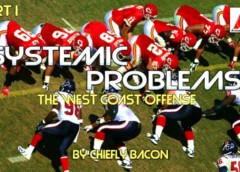Systemic Problems- Part I:
The West Coast Offense
Everyone’s position on Alex Smith is established at this point. Rather than spend a ton of time on that, I thought it would be interesting to explore some of the Chiefs issues that more fans can agree on. In the NFL, there are a wide variety of offensive and defensive systems. There are three notable systems that the Chiefs run: The West Coast Offense, A Zone Blocking Run Scheme and a 3-4 Defense. It is my personal opinion that, in a perfect world, the WCO is the best offensive system, the ZBS is the best run blocking system, and the 3-4 is the best defensive system. What is the problem? Chiefs don’t live in a perfect world and, as a consequence, they’re running out-dated or sub-optimal systems that limit their ability to compete, come playoff time. Those problems start with the West Coast Offense.
The West Coast Offense: While a variety of offenses fall under the umbrella of “West Coast”, there are distinct factors that remain the same with each WCO.
#1. The West coast offense is a timing based offense, where the WRs routes are synced to the QBs drop. A QB drop, is the number of steps he takes back, from his starting point, before he stops to throw the ball. A short pass would be a three-step drop, a slightly longer would be a five step, and a deep throw would be a seven step drop. This, of course, assumes that the primary read (target the QB is looking for) is open. If he’s not, successive routes should be timed out to come open as the QB would be coming off the previous read. When well executed, this offense allows the QB to quickly progress through his reads, and easily find WRs who are open, or, better yet, throw to WRs who will be open when the ball gets there. The potential problems that arise, in this system, are WRs who don’t run their routes precisely, a QB who can’t read a zone blitz, or disguised zone coverage and a failure to properly sync the QBs drop with the WRs routes.
#2. The West Coast offense is multiple. This means they run many different plays out of each formation and run a lot of formations. This leads to a very large playbook, and some very wordy play-calls. At its best, this makes the offense impossible to predict, and provides them with a huge arsenal of plays to attack various defenses. The problems that arise from this, are that the playbook is very difficult to learn. This means players take a long time to learn the system. While a rookie WR can start in a WCO, it’s generally the exception rather than the rule. The complexity of marrying a myriad of plays, with precise timing and crisp routes is something few rookies and many vets, can’t pull off in a single season. In fact, many WRs don’t truly master a WCO till their third year in the system.
What Does This Mean For The Chiefs: Back when Andy Reid started coaching, NFL teams had a lot more time to practice. Prior to the 2011 collective bargaining agreement, teams had five more weeks of off-season activities, and QBs were allowed to spend more time with coaches reviewing tape. This solved a lot of the problems that the WCO faces. QBs, WRs and TEs, had the practice time to properly sync their routes and put what they remembered from the playbook, on the field. With drastically reduced practice time, and less time for tape review, WCO’s have become increasingly reliant on veteran WRs. The loss of a quality receiver hurts most teams, for WCO teams, it’s a huge blow. Chiefs offense, at the beginning of year, shows you the potential of the WCO. They had the best offense in the league. It only took losing two WRs, Conely and Wilson, to derail the entire thing and reveal the major issue with the WCO.
 Tyreek Hill and Demarcus Robinson are both only in their 2nd year in the system. Smith’s timing is not properly synced with either of them. Hill’s speed, and ability to adjust to throws has helped, but without a veteran WR (DAT doesn’t count because he’s not good) Chiefs offense has sputtered and died. In the NFL today, you will deal with injuries and, because of the way the salary cap works, roster turnover. It is not reasonable for a team to need 4-5 WRs with 3+ years of experience on the roster. As good as WCO can be, it’s always an injury or two away from being far less effective.
Tyreek Hill and Demarcus Robinson are both only in their 2nd year in the system. Smith’s timing is not properly synced with either of them. Hill’s speed, and ability to adjust to throws has helped, but without a veteran WR (DAT doesn’t count because he’s not good) Chiefs offense has sputtered and died. In the NFL today, you will deal with injuries and, because of the way the salary cap works, roster turnover. It is not reasonable for a team to need 4-5 WRs with 3+ years of experience on the roster. As good as WCO can be, it’s always an injury or two away from being far less effective.
Solution: The Erhardt-Perkins System:
If you want a more in depth read about the history of the Ernhardt-Perkins system, I recommend this article: http://grantland.com/features/how-terminology-erhardt-perkins-system-helped-maintain-dominance-tom-brady-patriots/ by Chris Brown, or read the chapter in his book “The Art Of Smart Football”, on the EP offense. Here, we’ll just examine a few key differences between the EP and WCO that make it a more viable option for modern NFL teams. What makes the Ernhardt-Perkins so different? It all starts with the play calling.
Unlike the WCO, the EP doesn’t have long complicated play calls for each play. Instead, it uses simple word associations for formations, or styles of play, and numbers or signs to denote routes. What does this mean exactly? While a Chiefs play call could be a 14-word jumble that takes a while to spit out in the huddle, the Patriots EP can be run from the no huddle, with a few words and some quick signs. The reason the Patriots no huddle is so effective, is that it’s not any different from their regular offense. The entire playbooks is available to Brady from the no huddle.
Aside from improving the no huddle offense, the EP also has the distinct advantage of being easier to learn. Outside the QB, nobody in the offense has to know what anybody else is doing. You know what position you’re playing and listen for your route. Instead of having to memorize a ton of plays, you just memorize a handful of routes. This is one reason why the Patriots offense can change so much from game to game. The only people who have to know the full play calls are the OC and the QB. In the NFL, where WRs are often injured, it’s critical to get new players up to speed, and the EP allows you to do that.
Another distinct advantage of a the EP is practice time. With limited time to practice plays, every second of training camp counts. If your play-call takes three seconds to communicate vs 10, that adds up to being able to practice more plays, or practice the same plays more times. Remember though, WRs are just practicing routes, or blocking patterns, so practicing a given play actually helps them get better at multiple potential play calls. The EP lacks the finesse and sophistication of the WCO, but it’s far easier to practice, execute, and acclimate new players to. You also don’t have to spend a chunk of training camp practicing a 2-minute offense, because your 2-minute offense is the same as your regular offense, just without a huddle.
Chiefs offense still has the potential to be the best in the league, as a WCO, but only if their players can stay healthy. If they were willing to make a big change, in the way they call plays, it could level out the offensive performance. While their peak performance might dip, we would likely see less abysmal performances, like the Giants game. New WRs and TEs could quickly get involved in the offense. Smith (or whoever the QB may be) would have far more options at his disposal to deal with surprise motions from the defense.
Bonus Thought: If you follow me on twitter, you’ve already heard me say this, but I think the WCO is the reason Chiefs hang on to Demetrius Harris (and hung on to Ross Travis for so long). If you can find a player who’s good enough to keep, but not so good as to be expensive, you can fit more veterans on the roster who know the playbook. For the WCO a mediocre veteran is often more useful than a talented rookie who doesn’t know the playbook, or have his routes properly synced.
You can read “Systemic Problems- Part II: Zone Blocking” tomorrow morning here at ArrowheadOne.

If you are viewing this in Apple News and would like to join the Discussion, [GO HERE.](http://arrowheadone.com/systemic-problems-part-i-the-west-coast-offense/#disqus_thread)


